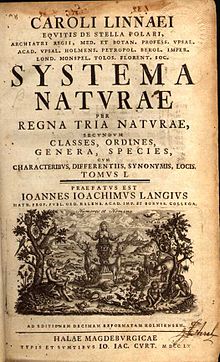Systema Naturae
Systema Naturae (1735–1770) – jedna z głównych prac szwedzkiego lekarza medycyny i przyrodnika Karola Linneusza. Jej pełny tytuł to:
Systema naturae per regna tria naturae, secundum classes, ordines, genera, species, cum characteribus, differentiis, synonymis, locis.
Książka stała się szybko bardzo popularna, dlatego Linneusz kontynuował wydawanie kolejnych edycji i poszerzanie dzieła od 11 stron pierwszej edycji (1735 r.)[1][2] do ponad 6000 stron w ostatniej, trzynastej edycji uzupełnionej przez Johanna Friedricha Gmelina, wydanej w latach 1788–1793 w trzech tomach (z czego pierwszy liczył 7 części, a drugi – 2)[3]. W X edycji Linneusz wyróżnił trzy królestwa, zwierzęta, rośliny i minerały. Te ostatnie podzielił na trzy klasy: skały, minerały i skamieniałości[4].
W miarę rozwoju pracy, Linneusz dokonywał zmian: w pierwszej edycji wieloryby były klasyfikowane jako ryby; w 10. edycji, opublikowanej w 1758, wieloryby zostały przeniesione do ssaków[5]. W tej samej edycji wprowadził dwie części nazwy (nazewnictwo binominalne) dla gatunków zwierząt, niektóre wprowadził dla gatunków roślin w publikacji z 1753 r. – Species Plantarum[6].
Dziesiątą edycję (1758) tej książki uważa się za początek nomenklatury zoologicznej[1]. Wprowadzona przez Linneusza klasyfikacja stała się podstawą naukowej klasyfikacji biologicznej organizmów[7].
Przypisy
- ↑ a b T.S. Bellows, T.W. Fisher: Handbook of biological control. Principles and applications of biological contro. San Diego: Academic Press, 1999, s. 44–45. ISBN 978-0-12-257305-7.
- ↑ L. Schiebinger, Cv. Linné. Why mammals are called mammals: gender politics in eighteenth-century natural history. „Am Hist Rev”. 98 (2), s. 382–411, Apr 1993. PMID: 11623150.
- ↑ John Hopkinson. Dates of Publication of the Separate Parts of Gmelin’s Edition (13th) of the ‘Systema Naturae’ of Linnaeus. „Proceedings of the Zoological Society of London”. 77 (4), s. 1035–1037, 1907. DOI: 10.1111/j.1469-7998.1907.tb06965.x. ISSN 03702774 (ang.).
- ↑ Sten Lindroth: Linnaeus as a minerologist. [dostęp 2014-05-02].
- ↑ Systema Naturae – an epoch-making book. [dostęp 2014-05-16].
- ↑ Gordh Gordon, Beardsley John: Taxonomy and biological control. W: T. Richard Fisher, T.S. Bellows, L.E. Caltagirone: Handbook of biological control: principles and applications of biological control. San Diego: Academic, 1999, s. 45–55. ISBN 978-0-12-257305-7.
- ↑ S. Müller-Wille. Collection and collation: theory and practice of Linnaean botany. „Stud Hist Philos Biol Biomed Sci”. 38 (3), s. 541–562, Sep 2007. DOI: 10.1016/j.shpsc.2007.06.010. PMID: 17893064.
Linki zewnętrzne
- Linné on line
- 12 edition (in three volumes) online at gallica
- 13th edition (Volume I, 532 pages) online at Google Book Search
Media użyte na tej stronie
Cover of w:en:Systema Naturae, 10th edition, not the original from 1758 but a modified reprint version from 1760 not printed in Sweden (but in Halle, Germany). The text of the title page was not identical in orthography with the original edition published in 1758 in Stockholm, the letters æ and u in the original Swedish edition (Linnæi, naturæ, tomus etc.) were replaced by ae and v in the German edition (Linnaei, natvrae, tomvs etc). Since all zoological works published by the author in Sweden between 1735 und 1761 and authorized by himself spelled æ and not ae, this title page is not representative for illustrating the original work of Carl Linnæus.

